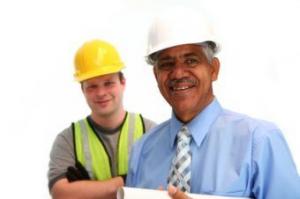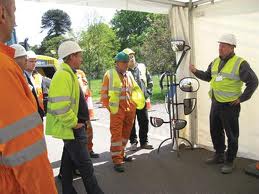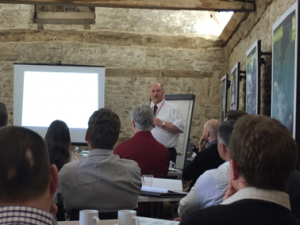Managing Contractors 
I have recently been investigating a dangerous incident that occurred at a large employer’s business. One of the underlying causes was insufficient management of contractors working on their site.
So, this week I thought it might be prudent to look at what you must be doing when you engage contractors.
A contractor is anyone you ask to do work for you who is not an employee. So that could be:
- A tradesman such as a plumber or electrician you engage to carry out a building or repair job.
- A cleaning company that you engage to clean your offices.
- A freelance consultant that you engage to help you on a project
However, it doesn’t apply to temporary or agency workers – there is more specific information about them at www.hse.gov.uk/workers/agencyworkers.htm.
This week’s 2 recent HSE case look at:
- An unregistered plumber has been sentenced after conducting gas work and leaving it in a dangerous state
- A Birmingham electrician has been ordered to carry out unpaid work in the community after his trainee fell three and a half metres through a plasterboard ceiling.
As ever, if you have a subject that you would like us to cover one week, please contact us by phone 01458 253682, email or via our Facebook page or by Twitter
Managing Contractors
The incident I was investigating was for a large employer that regularly engages contractors on their site with no problems occurring. However, when they had an incident and called The Wilkins Safety Group in to investigate, we found mistakes that many similar companies also commit.
As, with many other companies, they used contractors that they have worked with in the past and been happy with. But they did not have an official “Approved Contractors” list where contractors are regularly audited and checked. Yes they asked for and received Risk Assessments Method Statements, RAMS, from contractors, but nobody checked that the contractor’s employees knew what was in these RAMS.
So what are your responsibilities when you engage contractors and what checks etc. should you be carrying out?
What are your responsibilities?
Both you and the contractor you use have responsibilities under health and safety law. Everyone needs to take the right precautions to reduce the risks of workplace dangers to employees and the public. Make sure everyone understands the part they need to play in ensuring health and safety.
So you need to ensure that you have made the contractor fully aware of the risks that are particular to your workplace. Remember, you know your workplace and the day to day risks but the contractor, and especially their employees, may not.
What you need to do
Identify the job
Identify all aspects of the work you want the contractor to do. Consider the health and safety implications of the job. Remember, the level of risk will depend on the nature and complexity of the work. You should provide potential contractors with this information and make sure they know and understand the performance you expect of them. You could include this information in the job specification.
All the contractor’s operatives should be given a site-specific induction where you can ensure that they are told about your particular site rules, fire evacuation controls, no-go areas, Permit to Work procedures, PPE requirements etc. etc.
Remember!
If the work is construction or building work, as the client you have duties under the Construction (Design and Management) Regulations 2015. These include ensuring that the contractors and professional you choose are competent from a health and safety point of view.
Select a suitable contractor
You will need to satisfy yourself that the contractor you choose can do the job safely and without risks to health. This means making enquiries about the competence of the contractor – do they have the right combination of skills, experience and knowledge? The degree of competence required will depend on the work. Similarly, the level of enquiries you make should be determined by the level of risks and the complexity of the job.
Examples of questions you could ask potential contractors include:
- What arrangements will you have for managing the work? For example, who will be responsible, how will the work be supervised, what checks do you make on equipment and materials etc?
- Will you be using subcontractors and if so how will you check they are competent? The level of competence for subcontractors will depend on the risk and the complexity of the work.
- What is your recent health and safety performance? For example, how many accidents and cases of ill health have you had, has HSE taken any action taken against you?
- Do you have a written health and safety policy? (This is only a requirement if five or more people are employed.)
- Can you provide existing risk assessments done for similar jobs? Again, written risk assessments are only required by law if five or more people are employed.
- What qualifications, skills and experience do you have in this type of work?
- What health and safety information and training do you provide for your site manager and workers?
- If required, do you have Employers’ Liability Compulsory Insurance?
These questions will help you find out whether the contractor is complying with their duties under health and safety law. You can then decide how much evidence is needed to support what you have been told.
Other questions you can ask which may help you to decide which contractor to choose include:
- Do they have any independent assessment of their competence?
- Are they members of a trade association or professional body?
- Will they be producing a safety method statement for the job? A safety methodstatement is not required by law. It does however describe in a logical sequence exactly how a job is to be carried out in a safe manner and without risks to health. It includes all the risks identified in the risk assessment and the measures needed to control those risks. This allows the job to be properly planned and resourced.
Case study
A tree surgeon was felling a branch, when it fell into a neighbouring garden, damaging a fence panel. An hour earlier the neighbour had been in the garden playing with her 20-month-old child. The tree surgeon had neither the qualifications to use a chainsaw nor the skill to carry out the job safely. If the property developer who hired the tree surgeon had checked that he was competent to carry out the work, this incident would have been avoided.
Don’t assume someone is competent, check it yourself.
Assess the risks of the work
Both you and the contractor need to think about the planned work:
- What can harm people?
- Who might be harmed and how?
- How will you control the risks?
You should already have a risk assessment for the work activities of your own business. Make sure your assessment covers risks to contractors from your business (eg asbestos, on-site vehicles). The contractor must assess the risks for the contracted work and then both of you must get together to consider any risks from each other’s work that could affect the health and safety of the workforce or anyone else.
You need to think about any risks to your workers and members of the public, because you have contractors on site. Also, make sure you agree the measures needed to control risk with the contractor before work starts.
Stop Check!
Case Study
A worker was killed when she was run over by a vehicle operated by a contractor. Neither the employer nor the contractor had identified pedestrian routes to keep pedestrians separate from moving vehicles. Additionally, the contractor hadn’t given his drivers adequate training to make sure they operated the vehicles safely. The employer should have identified risks from the contractor being on site and agreed measures to control those risks before the work started.
Provide information, instruction and trainingYou and the contractor need to communicate with each other throughout the process. Make sure that the contractor and their employees have information on:
- health and safety risks they may face;
- measures in place to deal with those risks;
- your emergency procedures.
The information you provide should be in a form that is easy to understand.
Similarly, you must provide clear instructions, information and adequate training for your own employees.
Case study
A farm worker received internal injuries and severe burns from electric shock when he lifted an irrigation pipe and it contacted 33 000 V overhead power lines.
The employer had not discussed the presence of the overhead lines and identified a safe way of moving the irrigation pipes. The employer should have made the contractor aware of the risks he faced and agreed a method of work before the job was started.
Don’t assume that contractors will be aware of all risks, even if they seem obvious to you.
Cooperate and coordinate with the contractor
You and the contractor must work together and coordinate your activities, to make sure the work can be done safely and without risks to health. One way of doing this is to have regular meetings throughout. The level of cooperation and coordination needed will depend on:
- the job to be done;
- the number of contractors (or subcontractors) involved;
- the risks involved.
Case study
A delivery driver was injured when a lift truck hit him as he walked into a factory to find out where he should deliver his load.
The employer should have identified the risks to the driver and given him clear instructions.
Consult the workforce
You have to consult your employees on health and safety matters. Involving your workers will help you make better decisions on the actual risks and the measures to control them. Involve your workers in the process and consult them on:
- how the contractor’s work will affect their health and safety;
- information and training;
- making sure they know how to raise any concerns they may have about the contractors and their work.
Case study
A contractor working at a newsprint firm had his leg amputated when it was trapped in machinery. He had climbed onto the conveyor to move a reel that was stuck and his leg was caught between the roller and the moving slatted metal conveyor.
The employer should have identified the risks from the work and provided a safe system of carrying it out. If the employer had consulted employees, this method of working would have been identified and controls put in place to prevent the accident.
Manage and supervise the work
Decide what you need to do to manage contractors’ work. The measures you put in place should be consistent with the level of risk, i.e. the greater the risk, the more you need to do.
Consider:
- Who will be responsible for the work and what do you expect them to do?
- Who will supervise the work and how?
- How will the work be done and what precautions will be taken?
- What equipment should or should not be worked on/used?
- What personal protective equipment is to be used and who will provide it?
- What are the working procedures, including any permits-to-work?
- What are the arrangements for stopping the work, if there are serious health and safety concerns?
Once the work has started, make sure you keep a check on how the work is going against what you have agreed. You can do this by:
- regular checks – ask yourself ‘are the control measures working?’
- investigating if things go wrong, eg near misses, accidents, ill health. Ask yourself ‘what went wrong and what can we do to prevent it happening again?’
After the job is finished, there will be benefits in reviewing and learning from any lessons to see if performance can be improved in future.
Case study
Contractors were employed to install new guttering on a 7 m high building. The workers could get onto the roof from a mobile tower at the front of the building, but there wasn’t any equipment to stop them falling at the back where work was taking place.
The employer should have made a decision about how the work would be carried out, what equipment would be used and who would supply it before work started.
Don’t assume that the contractor will have the right equipment to carry out the job safely.
The Wilkins Safety Group are able to audit contractors on your behalf and will vet their RAMS etc. and can then visit the works to ensure that everything is being run safely.
With these checks being carried out, you can concentrate on running your business, knowing that the contractors you have on site are being managed properly.
If you would like any further help or support, please please contact us by phone 01458 253682, email or via our Facebook page or by Twitter.
We had a good exhibition on the 30th!!
As part of our 25th anniversary celebrations the Wilkins Safety Group are exhibiting at 3 Business Expos this year in Exeter, Swindon and Bristol.
The first of these was at this year’s South West Business Expo, probably the largest business expo in the South West.
We were visited by a steady stream of people throughout the day and have arranged some meetings with potential clients over the next few weeks.
We also had a lot of interest in our Prize Draw throughout the day with prizes being drawn every hour including: Champagne, Prosecco, and Chocolates.
Our next Exhibition is at Swindon on 29th June – We look forward to seeing you there!



Training Courses
WE have already run a number of courses in 2017.
There are more courses to follow in May and June – These will be listed shortly.
We are also looking to run some short Health and Safety awareness sessions to emphasise the need for improving your H&S procedures.
Also remember we are still available for running “In House” courses and are looking to add new training courses to our list.
If you have any questions about these courses or any other training or would like us to run a particular course for you, call Jon Wilkins of the Wilkins Safety Group on 01458 253682 or email him.
